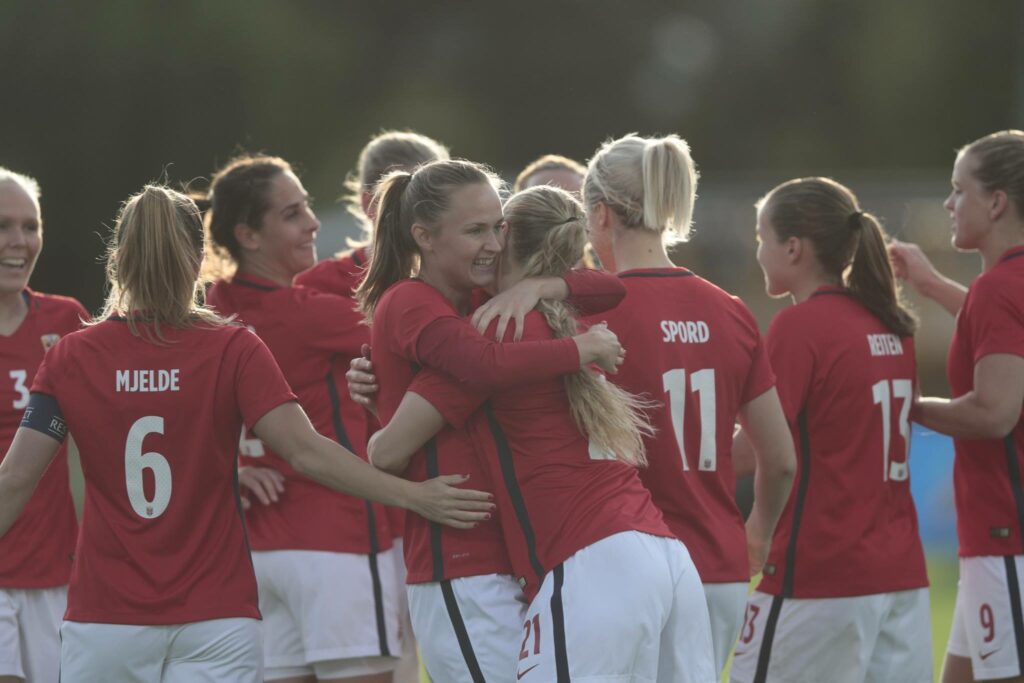In a precedent-setting move, the Norwegian Football Association has decided to pay its women’s national team players the same as their male counterparts

Earlier this month, the Norwegian Football Association announced that under a new agreement it will pay its women’s and men’s national team players equally for representing their country. According to the head of Norway’s players’ union, Joachim Walltin, the agreement is a world first. The women’s national team players are set to receive six million Norwegian kroner per year (roughly $750,000), almost doubling the previous amount of 3.1 million kroner (about $387,000). What may seem like a simple and obvious step to take is nevertheless a hugely significant one given the extent of the gap in pay and employment conditions between women’s and men’s soccer around the world. It also lays down the challenge to other national associations to front up and treat their own women’s teams equally.
The agreement is not only overdue recognition of the success of the women’s team, which has won the UEFA Women’s Champions twice, as well as the World Cup and gold at the Olympics, but, more importantly, treating the women’s and men’s teams equally is simply the right thing to do regardless of their success. In a laudable departure from the prevailing dynamic elsewhere in the world, Walltin says that it was actually the Norwegian FA that proposed paying its international players equally, a move supported by the men’s team. But it’s worth noting that this move did not occur in a vacuum. Like many of their counterparts around the world, Norwegian women often have to juggle playing soccer alongside school or outside employment. The agreement also took place in the context of women around the world becoming more and more vocal in their demands for equal treatment in recent years and pushing back against the status quo.
The issues of the pay gaps, lack of investment, substandard facilities, and a general lack of respect for women’s soccer are by no means unique to Norway. In the US, the women’s team, winners of multiple World Cup and Olympic tournaments, have been engaged in a long-term battle with the US Soccer Federation for equal treatment. While US Soccer and the women’s national team completed a new collective bargaining agreement earlier this year that meant an increase in base pay and bonuses, the agreement stopped short of mandating equal pay with the men’s team. Other ongoing issues also remain, including the women’s team being made to play on artificial turf fields.
The struggle for equal treatment extends beyond Norway and the US. To cite just a few examples: in 2015, the Australian women’s national team had their tour of the US cancelled due to a pay dispute with their national association; in 2016, the Nigerian team protested outside parliament to demand their unpaid win bonuses from the Nigerian Football Federation after winning the African Cup of Nations; earlier this year, Abby Erceg, the captain of the New Zealand women’s national team, announced that she was quitting because the players were “undervalued” by New Zealand Football; and just recently, an ongoing pay dispute between the Danish team and the national association led to the cancellation of a match against Sweden.
One of the more notable and welcome parts of the agreement between the Norwegian FA and its national team players involves a 550,000 kroner (around $69,000) contribution from the male players, which they currently receive for commercial activities, towards the pay increase for the female players. While this constitutes a relatively small amount for the men, it’s an important symbol of their solidarity with, and support for, their counterparts and sets a positive example that others around the world should take note of.
Caroline Graham Hansen, a winger in the women’s national team, expressed her gratitude to the men’s team in an Instagram post:
https://www.instagram.com/p/BZ6p3M1h_WG/?hl=en
For some men though, this great news was clearly too much. Matthew Syed of The Times of London felt it necessary to tell the Norwegian women’s players that they are undeserving of equal pay because they do not do the same job as the men’s players and that the agreement is actually “the opposite” of a step towards gender equality. He helpfully pointed out that the “key principle in employment equality is meritocracy” and that actually the players should wait for the meritocratic system that we all know exists and works so well to deliver employment equality. That is the same tradition of meritocracy that saw the Norwegian FA take a mere 74 years from its founding to recognise the women’s game, which it finally did so in 1976. Or that that saw the English FA ban women’s football for 50 years, until 1971. Or that saw FIFA take until 1991 to hold the first women’s World Cup, 61 years after the first men’s tournament was held.
Of course we are not operating in a meritocracy and everyone does not start from an equal footing. Instead we are operating in an environment in which women’s soccer around the world has suffered from systematic discrimination and underinvestment, and players have been systematically undervalued. Equal pay will not solve all these issues overnight, but the Norwegian FA has now taken a step in the right direction and it is hopefully a sign of things to come. Indeed, following Norway’s announcement, FIFPro, the international trade union representing professional footballers, tweeted:
We know of another country that has secured equal rights. Sworn to secrecy. Watch this space. Momentum building.https://t.co/dNj1bdUIyf
— FIFPRO (@FIFPRO) October 7, 2017
Investing in women’s soccer via pay parity is not a “handout” as Syed derisively terms it, but simply what female players deserve, regardless of whether they are champions or not, and what equality demands.
Follow Aubrey on Twitter @AubBloomfield.
